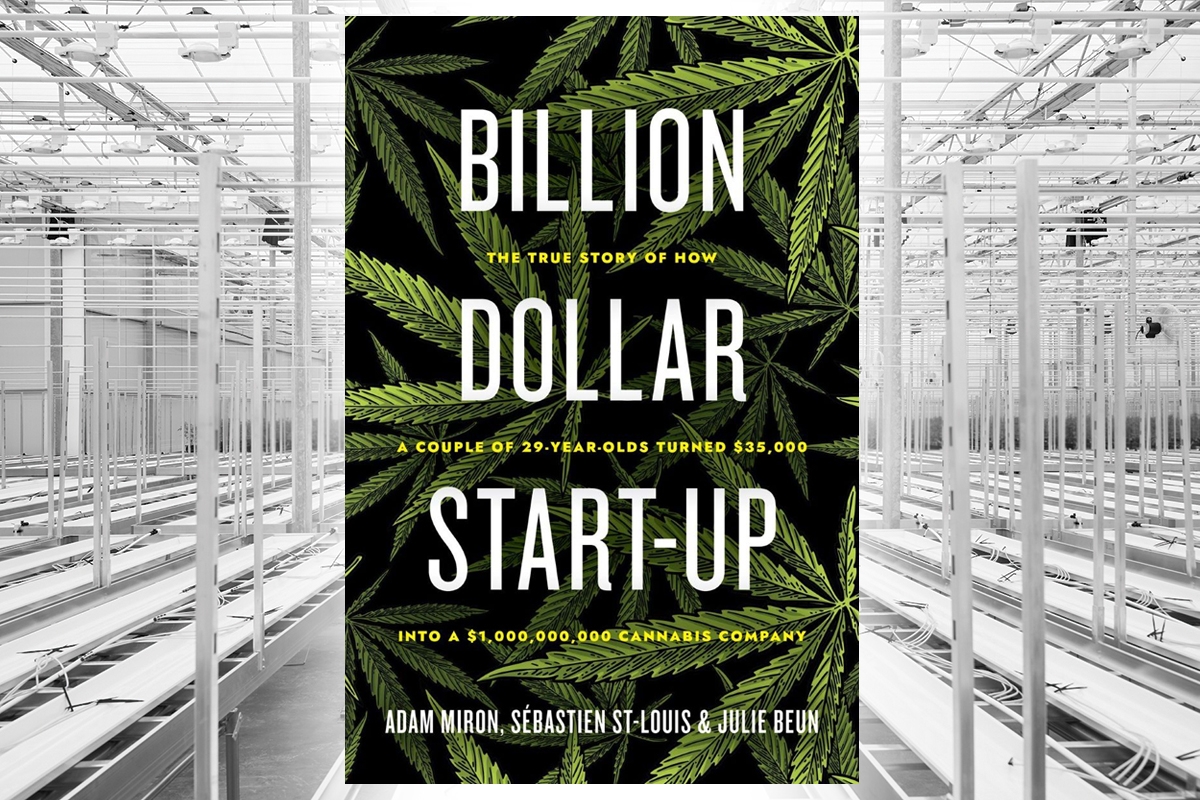
How a couple of 29-year-old Ottawan’s turned $35,000 into a billion-dollar cannabis company
It only took five years for two brothers-in-law to create a billion-dollar, award-winning, take-no-prisoners cannabis company called HEXO. How did they do it? That’s the story.
From early roadblocks and devastating personal and financial setbacks to explosive growth and some of the biggest cannabis deals in global history, Billion Dollar Start-Up not only recounts the HEXO story but the history of Canada’s momentous road to legalization.
In this part fast-paced memoir, part high-octane business book, writer and journalist Julie Beun gives us an intimate look at the life of a start-up and the ferocious entrepreneurial drive it takes to succeed ? written in real-time, as the story unfolded.
Throughout history, there have been fewer than 100 Canadians who have started a company and lived to see it become worth one billion dollars. Adam Miron and Sébastien St-Louis are two of them. This is their story.
Reviews
“A story of two young men with an insatiable thirst for success and learning is compelling. The ‘Billion Dollar Lessons’ that punctuate the story are essential reading for any budding entrepreneur who aspires to start the next billion-dollar company.” ? Michael Henry, Dean, School of Business & Economics, Thompson Rivers University
“How fun to now get a behind-the-scenes peek at the phrenetic growth of HEXO against the backdrop of cannabis legalization. It’s an entrepreneur’s dream . . . on steroids!” ? Trina Fraser, partner, Brazeau Seller Law, CannaLaw® group
“Two young Canadians saw a business opportunity and threw themselves into it. Their story is one of hard work, high energy, endless ingenuity, and above all, persistence. Canada's budding entrepreneurs can be inspired by the path blazed by Adam and Seb.” ? Dalton McGuinty, Ontario's 24th Premier
“A fascinating tale of two young entrepreneurs navigating through an ocean of complex health regulations, filled with finance sharks and storms of uncertainty. One of the few true success stories in the frantic new cannabis business.” ? Tristan Péloquin, cannabis beat reporter, La Presse
“A front-row seat to the frenzy that drove Canada's cannabis industry to half the market capitalization of the country's gold mining industry. Compelling reading with real-world lessons you can actually use.” ? Steve Brearton, award-winning business journalist and writer
About the Authors
Adam Miron (Ottawa, ON) With at least 20 start-ups under his belt, Adam Miron is a well-known figure in political and media circles in Ottawa and across Canada. Adam is the executive chairman of the Ottawa-based blockchain innovation company Brane.
Sébastien St-Louis (Ottawa, ON) Sébastien is one of the longest-serving and most dynamic CEOs in Canada’s expanding cannabis industry.
Julie Beun (Ottawa, ON) From 2014 to 2019, Julie had a privileged front-row seat to HEXO’s remarkable evolution as its publicist, content strategist, and senior writer. As a journalist, news editor, and foreign correspondent, Julie has written articles with a national and international scope in Canada, the U.S., and Australia. She is currently a marketing communications and brand consultant who owns J Beun Media, a marketing communications company.
The True Story of How a Couple of 29-Year-Olds Turned $35,000 into a $1,000,000,000 Cannabis Company
Hardcover – Feb. 2, 2021
by Adam Miron (Author), Sébastien St-Louis (Author), Julie Beun (Author), Don Wright (Foreword)
Read an excerpt from the book
1 P.M., MARCH 2014 BOTANIX FARM MASSON-ANGERS, QUEBEC
With the deadline for transferring plants looming and no word from Health Canada, things looked grim. But, as they had before, Adam and Seb settled into the elegant give-and-take business relationship that had propelled them this far. Every day, the whiteboard was covered with notes and plans. Every day, Adam wrote lists, updated spreadsheets, and made calls. Every day, Seb looked for ways to get their medical marijuana business on its feet. When the answer finally came, it wasn’t from Health Canada at all but from a contact at the Gatineau municipal offices.
According to Seb’s source, Hydropothecary wasn’t the sole medical marijuana applicant in Gatineau. Did he know a guy named Louis Gagnon of Botanix, up in Masson-Angers? Seb didn’t, but like anyone who’d ever shopped at the Rona hardware chain, he’d heard of Botanix, a Quebec-based company that supplied the hardware chain with ornamental bushes and exotic flowers. Louis Gagnon, it turned out, was a master grower who had a 7,000-square-foot greenhouse and a staging licence from Health Canada. That meant that he wasn’t a full LP and therefore wasn’t listed on the Health Canada website, but he did have a licence to grow medical marijuana plants. He just couldn’t process or sell them.
Seb’s mind raced ahead to the possibilities. He called Louis almost immediately to set up a meeting, then opened his laptop and checked a satellite map for the 68-acre Botanix farm on Chemin de la Rive. He made an approving noise in the back of his throat. It was just out of town, sandwiched between Lièvre River to the north and the Ottawa River to the south, near the Cumberland ferry landing. “Nice spot,” he thought. “Very nice.”
The question was, what did he want to know from this Louis guy? Obviously, he wanted to know what the hell he’d done to get a staging licence. Who had he dealt with? More importantly, could they do a deal that would hitch Hydropothecary to the staging licence Health Canada gave to Botanix while he and Adam waited for the industrial property at Rue Bombardier to come online?
Climbing into the Grand Am a few days later on their way to meet Louis, Adam and Seb looked like a pair of popinjays headed to a party. Seb eschewed his standard Under Armour in favour of a standard salesman’s striped suit matched with a pink striped shirt. It was a lot of stripes. For his part, Adam had delved into his tie drawer and went straight to his most cherished items: two silk Zegnas. His hand hovered over the choices, one for summer and one for winter. Yes, the summer tie. It was a vibrant pink paisley number that was sure to impress.
A half hour later and they were driving slowly down the muddy, unpaved Chemin de la Rive. On the right, the banks of Lièvre River dropped precipitously to the water. To the left, past a massive stand of trees that acted as a buffer to a regional road leading to the Cumberland ferry, stood a charming, modest redbrick farmhouse, complete with gabled roof and decorative gingerbread trim. The rest of the site was a hodgepodge of seasonal outbuildings, retail, and storage facilities and garages, all bustling with spring activity.
Adam and Seb parked the car, walked up the wooden steps to the front door, and knocked. It almost immediately swung open. Louis Gagnon stood in the doorway. “Bonjour, ça va? Vous-êtes Sébastien St-Louis? Et vous . . . vous-êtes . . . Adam? Bonjour. Entrez, s’il vous plait.”
Offering them a coffee, along with a bemused “bon cravat” to Adam’s splendid tie, they got down to business. Or rather, Seb and Louis talked, and Adam watched Louis. The man appeared to be genetically rumpled: everything from the deeply lined face from years of working outdoors to the sort-of-but-not-really-fitting work pants and nondescript green-grey windbreaker had the air of being pulled out of the dryer damp and thrown in a basket. But he was affable enough, curious, and definitely interested in why these two dandies were visiting a working farm in the middle of the day.
Adam watched Seb, too. In this environment, Seb was in a class on his own. He asked dozens of questions, and listened closely to the answers. Louis walked them through his facility with some pride, talked about the numbers of people he had working for him, and introduced them around.
It was clearly a working farm with plenty of things that needed replacing or upgrading, but as a future marijuana facility, they saw where it could end up with the right injection of money. There was already a vault in an underground bunker for dried product storage. By the end of the meeting, Louis agreed to rent them a corner of the greenhouse. He would tend to the plants with the Hydropothecary employees, and Hydropothecary would supply Louis with seeds to get his production started. The Rue Bombardier facility could remain part of the plan, maybe as something else, like a cannabis genetics lab. More exciting than all of that, however, was the licence itself.
Before they left, Louis showed them his Health Canada certificate. Adam held it for a few minutes, noting the weight of the paper, the smell of the ink. He memorized the number etched onto it and the exact shade of crimson of the seal. It felt like currency and looked like a key to the future. It also represented the closest he and Seb had come to realizing their dream and, although it belonged to someone else, it was a significant move forward for them. He handed it back reluctantly.
The next step was to involve their lawyer. He would paper up the deal immediately, and they could bring in the plants before the March 31 deadline, now only a few days away. As they drove back down Autoroute 50 to Ottawa, their smiles were more genuine than they had been in a very long time.
It was progress. But it wasn’t quite enough progress for Seb.
Anyone who has seen a scent hound single-mindedly trailing its prey would be familiar with the laser focus Seb gave his next move. He had mused aloud to Adam on the trip home, wouldn’t it be great if they could just buy out Louis, the farm, the licence, everything? Then they’d really be in business. They wouldn’t be at the mercy of anyone. What did Adam think about that?
Adam chuckled. Good old Seb. Always charging up the next hill, sword out, voice in full howl.
“Let’s just see how this plays out, Seb. We don’t know this guy, but we’ve made real progress. I think we should just sit on it for the moment. But I like where you’re headed.”
The Merriam-Webster dictionary defines progress as “a forward or onward movement.” Progress requires an onward propulsion and energy. But, as with any destination in business, it should always be a little bit out of reach, just over the crest of ideation. At least that’s what Seb was telling himself when he contacted Louis again to have a chat. A long chat.
A few days after their initial meeting, Seb burst into the basement office, eyes sparkling. He wasn’t even trying to suppress his excitement. Nor did he give Adam a chance to ask why he was there.
“Look, I know you told me not to do it. I know! But I couldn’t help myself, I did it! I called him back. I did a deal, a huge deal. We’ve got it all . . . the house, the buildings, the land, the licence! We’ve got a pot farm!”
Adam’s eyes widened in astonishment.
“Are you fucking KIDDING ME?”
2 P.M., APRIL 2014 ADAM’S BASEMENT OFFICE, CENTRETOWN OTTAWA, ONTARIO
Adam’s basement office is not a place for board meetings. Cramped and chilly despite the space heaters, it has nevertheless been the scene of countless light bulb moments, daily grinds, and bitter disappointments.
Today, however, it was a lecture theatre, with Sébastien teaching Adam and their lawyer, Karl, a class in the courage to win.
The hustle of entrepreneurship, Seb has always felt, is the courage to win, where you have to force your will forward to succeed and where, when others lose hope, you do not. It’s about recognizing your vulnerabilities and turning them into resilience. It’s also about dreaming bigger than everyone else, then executing on the dream.
Standing at the whiteboard with a blue and a red marker in hand, Seb went through the details of the deal he’d put together with Louis a few weeks earlier. As soon as the company is profitable, he explained, Louis would be a full partner, plus he’d receive $800,000, with other tranches of cash tied to profit. In the meantime, he’d be paid what they were paid, and he’d get the same 650,000 shares that Adam and Seb both had. (At least that was the plan. It took much longer than anyone expected to close the deal with Louis.)
“Wait, what? Are you fucking crazy? The guy’s a farmer growing ornamental shrubs! I’m not giving him a third of the company! We’ve worked way too much for this; we have too much sweat equity in it!”
Adam was incensed. He wanted this deal, but not like that. Not literally giving the farm away. He thought they had just bought it. Seb quietly capped his markers and placed them on the whiteboard ledge.
“Adam, listen to me. Do you want 20 percent of a $20 million company or 5 percent of a $1 billion company? Mmm? We have this shot. This one shot. You know what we’re up against. And if you want to keep those odds, we have to make deals like this. Now, let me explain.”
Until that moment, every decision made had been made by Adam and Seb together. This time, however, Seb had devised a robust, calculated plan on his own. He sat Adam down and went through it, line by line. He was seeking buy-in and approval, but it was clear to Adam that, when the titles were handed out, Seb’s would be “chief executive officer.”
“Seb was on a whole other level of enlightenment and understanding,” Adam recalls. “He wasn’t preaching, he was teaching. I was still uneasy with it, but I was convinced this was what we had to do at the end of the day. He wasn’t just a salesman or negotiator, he was a thinker and planner. It was great leadership, and I remember thinking, ‘Now we’re really starting. This is it.’”








